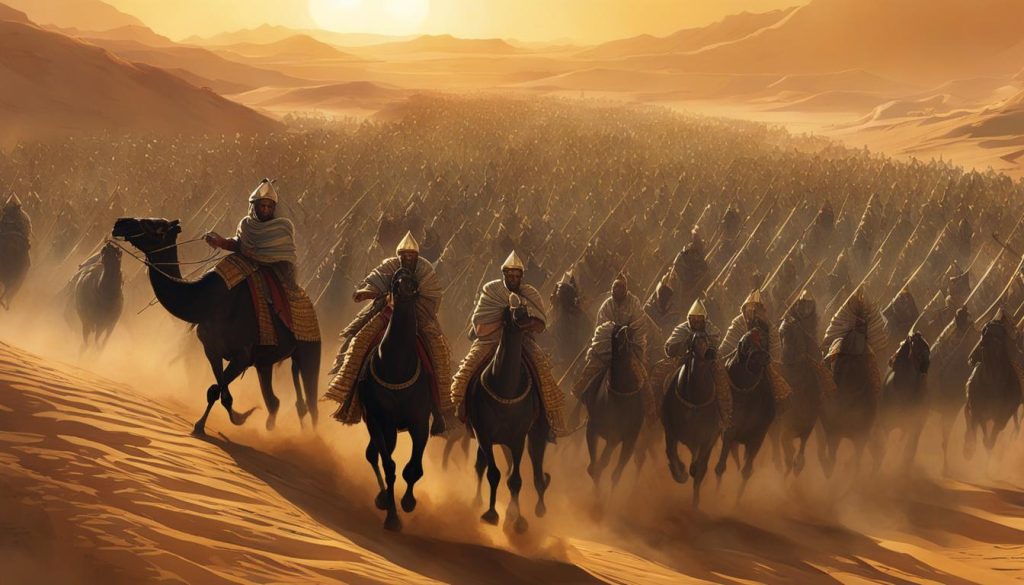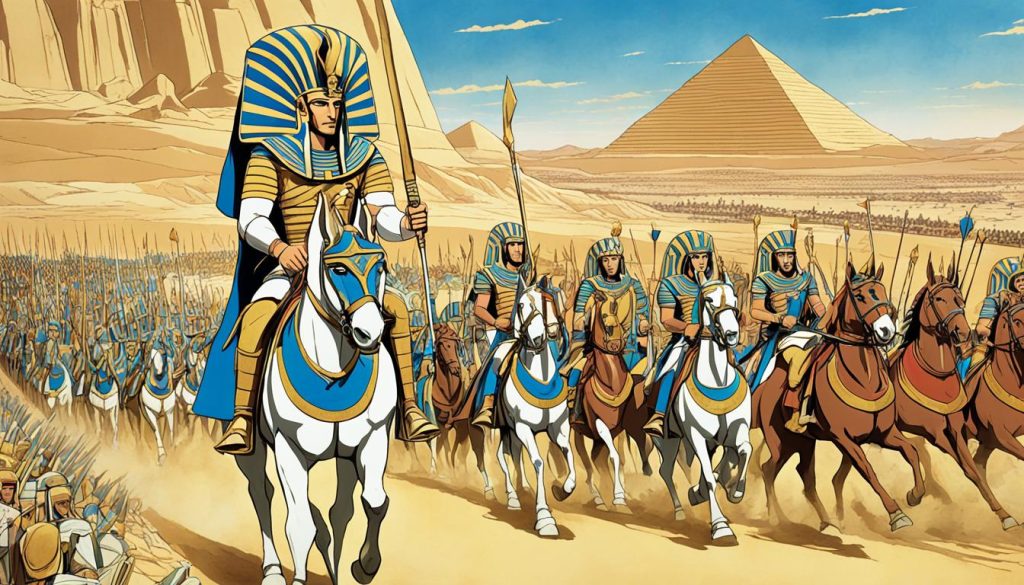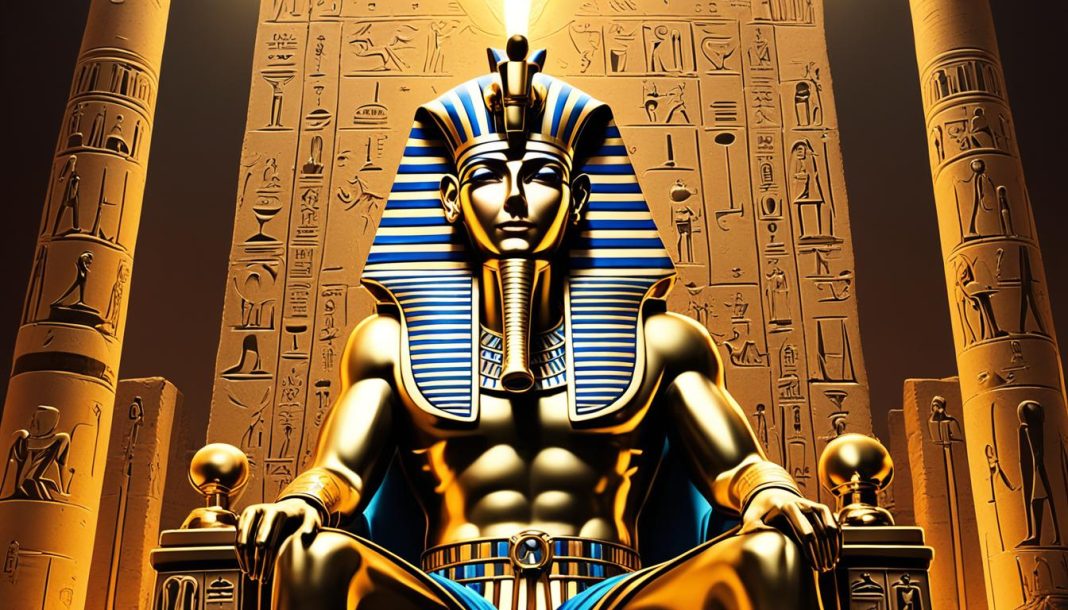Pharaoh Thutmose I, also known as Thutmosis or Tuthmosis I, was a significant figure in the history of Ancient Egypt. As the third pharaoh of the 18th Dynasty, he ruled during a time of prosperity and expansion for Egypt. But what exactly were his achievements, and how did he shape the course of Ancient Egyptian history?
In this article, we will delve into the life and reign of Pharaoh Thutmose I, exploring his military campaigns, building projects, and the lasting legacy he left behind. By examining his biography, we can gain a deeper understanding of one of the most fascinating rulers of Ancient Egypt.
Key Takeaways:
- Pharaoh Thutmose I was the third pharaoh of the 18th Dynasty of Egypt.
- He ruled for approximately 12 years, from 1506-1493 BC.
- Thutmose I expanded Egypt’s borders through military campaigns in the Levant and Nubia.
- He was known for his building projects, including temples and his own tomb in the Valley of the Kings.
- Pharaoh Thutmose I left a lasting legacy and his family continued to play significant roles in Egyptian history.
Now, let’s dive deeper into the fascinating life of Pharaoh Thutmose I and explore the impact he had on Ancient Egypt.
Early Life and Family of Pharaoh Thutmose I
Pharaoh Thutmose I’s family and early life were shrouded in mystery, but historical records provide some insight into his lineage and relationships. While the identity of his father remains uncertain, there is speculation that he may have been Amenhotep I, a previous pharaoh. Thutmose I’s mother, Senseneb, is believed to have been a lesser wife or concubine in the royal household.
Thutmose I’s family expanded with his marriage to Queen Ahmose, who may have been his own sister or the daughter of Ahmose I. Together, they had several children, including Thutmose II, Hatshepsut, Amenmose, Wadjmose, and Nefrubity. Thutmose I also had a son named Thutmose II with another wife, Mutnofret.
The descendants of Thutmose I would go on to play significant roles in the later history of Egypt, particularly his daughter, Hatshepsut, who became one of the most powerful female pharaohs in Egyptian history.
Reign of Pharaoh Thutmose I
Pharaoh Thutmose I’s reign, spanning from 1506 to 1493 BC, was marked by remarkable achievements and a period of stability and prosperity for Ancient Egypt.
During his rule, Thutmose I undertook military campaigns in the Levant and Nubia, expanding the borders of Egypt and solidifying its dominance in the region. His conquests surpassed those of his predecessors, showcasing his strategic prowess and military strength.
However, Pharaoh Thutmose I was not solely focused on warfare. He recognized the importance of building projects as a symbol of his power and legacy. He dedicated his efforts to constructing magnificent temples throughout Egypt, including the renowned pylons IV and V at Karnak. Additionally, Thutmose I initiated the construction of his own tomb in the Valley of the Kings, leading the way for future pharaohs to follow.
This timeline of achievements and strategic endeavors under Pharaoh Thutmose I’s rule established him as a significant figure in Ancient Egyptian history and set the stage for the prosperous reigns of his successors.
Egyptian Prosperity and Stability
Under the reign of Pharaoh Thutmose I, Egypt experienced a period of stability and prosperity. His military successes and expansionist policies contributed to the growth of the Egyptian empire, securing its dominance in the region. Additionally, the construction of temples and monumental structures not only displayed Pharaoh Thutmose I’s wealth and grandeur but also fostered a sense of national pride and unity among the Egyptian people.
Stay tuned for the upcoming sections to delve deeper into the military campaigns and building projects of Pharaoh Thutmose I, shedding light on his far-reaching impact on Ancient Egypt.
Military Campaigns under Pharaoh Thutmose I
Pharaoh Thutmose I, an ambitious ruler of Ancient Egypt, launched successful military campaigns that left a lasting impact on the region. His conquests in the Levant and Nubia expanded Egypt’s territory and solidified its dominance in these strategic areas.
Thutmose I’s military prowess was demonstrated through his victories over Nubian rebels and the capture of the Nubian king. As a sign of his triumph, the fallen king’s body was displayed, showcasing the might and power of Egypt under Thutmose I’s rule.
One of Thutmose I’s most significant military campaigns occurred in Syria, specifically at the city of Megiddo. Facing a formidable coalition, Thutmose I embarked on an extensive siege that lasted for eight months. Eventually, he emerged victorious, conquering Megiddo and further expanding Egypt’s reach in the region.
To visualize the extent of Pharaoh Thutmose I’s conquests, here is an image of the Levant and Nubia during his reign:
Building Projects of Pharaoh Thutmose I
Pharaoh Thutmose I left an indelible mark on Ancient Egypt through his impressive building projects. His grand vision and undeniable wealth resulted in the construction of various temples and monuments that still stand as testaments to his power and influence.
One of Thutmose I’s notable achievements was the construction of pylons IV and V at Karnak, part of the sprawling Karnak Temple Complex. These imposing structures served as monumental gateways, leading worshippers into the sacred space where they could pay homage to the gods. The intricate carvings and intricate architectural details on these pylons showcased the artistic prowess and cultural significance of the Ancient Egyptians.
Furthermore, Pharaoh Thutmose I commissioned the creation of majestic obelisks, towering stone structures that symbolized divine power. These obelisks, adorned with hieroglyphic inscriptions and intricate reliefs, were strategically placed in temple complexes and cities to serve as beacons of the pharaoh’s authority and the gods’ favor.
One of the most remarkable building projects of Thutmose I was the construction of a hypostyle hall at Karnak. This vast hall, supported by rows of towering columns, provided ample space for religious rituals and gatherings. Its intricate design, with detailed carvings and vibrant paintings, exemplified the artistic and architectural sophistication of the time.
However, perhaps the most significant construction endeavor of Thutmose I was the establishment of his own tomb in the Valley of the Kings. This decision marked a departure from previous burial practices, as he became the first confirmed king to build a tomb in this sacred valley. The tomb, meticulously carved into the rock, served as a final resting place fit for a pharaoh, showcasing his belief in the afterlife and his desire for eternal preservation.
These impressive building projects of Pharaoh Thutmose I continue to awe and inspire visitors to Egypt. They stand as lasting reminders of his reign, showcasing his wealth, power, and devotion to the gods. The temples, obelisks, and his tomb in the Valley of the Kings contribute to the rich architectural legacy of Ancient Egypt, captivating all who witness their grandeur.
Legacy of Pharaoh Thutmose I
Pharaoh Thutmose I left a lasting legacy in Ancient Egypt. His military campaigns expanded Egypt’s territory and secured its dominance in the region. Thutmose I’s building projects, including temples and his tomb in the Valley of the Kings, added to the architectural achievements of the time. His reign marked a period of stability and prosperity in Egypt.
Thutmose I’s impact on the ancient world cannot be understated. Through his strategic military campaigns, he not only expanded Egypt’s borders but also solidified its control over neighboring regions. His conquests ensured the security and dominance of Egypt, setting the stage for future pharaohs to further expand the empire.
Furthermore, Thutmose I’s architectural projects showcase his grandeur and vision as a pharaoh. His temples, such as the ones in Karnak, stand as magnificent testaments to his power and serve as important religious and cultural landmarks in Egypt. His own tomb in the Valley of the Kings demonstrates his desire for eternal remembrance as a revered ruler.
The Legacy Continues
“Pharaoh Thutmose I paved the way for a golden age in Ancient Egypt, leaving a blueprint for future rulers to follow. His military victories, coupled with his architectural marvels, shaped the destiny of the kingdom and inspired generations to come.”– Renowned Egyptologist, Dr. Zahi Hawass
Thutmose I’s impact extended beyond his own reign. His family, particularly his daughter Hatshepsut, would go on to play significant roles in the history of Egypt. Hatshepsut, one of the most powerful female pharaohs, continued her father’s legacy of expansion and construction, building upon the foundations he laid.
The enduring impact of Pharaoh Thutmose I’s reign is evident in the rich history and cultural heritage of Ancient Egypt. His legacy as a visionary leader and conqueror lives on, marking him as one of the most influential pharaohs in Egyptian history.
Thutmose I and Nubia
Pharaoh Thutmose I embarked on a military campaign in Nubia to suppress a rebellion against Egyptian rule. Traveling up the Nile, he personally led his forces into battle, ultimately defeating the Nubian king. Thutmose I’s victory was a significant milestone in Egyptian history, as it solidified Egyptian control over Nubia and integrated the region into the Egyptian empire.
After his successful Nubian campaign, Thutmose I recognized the importance of facilitating easier travel between Egypt and Nubia. To achieve this, he ordered the dredging of the canal at the first cataract. This canal served as a crucial trade route, allowing for smoother communication and the movement of goods between the two regions.
To showcase the historical significance of Thutmose I’s Nubian campaign, the image below depicts a carving from the temple of Thutmose I:

A Symbol of Victory
“The military campaign led by Pharaoh Thutmose I in Nubia demonstrated the strength and dominance of the Egyptian empire. By defeating the Nubian king and integrating Nubia into Egypt, Thutmose I secured Egypt’s control over the region and further expanded its influence.”
Thutmose I and the Levant
Pharaoh Thutmose I embarked on military campaigns in the Levant, expanding Egypt’s influence and control in the region. One of his notable campaigns took place in Syria, where Thutmose I crossed the Euphrates River, marking the farthest north any Egyptian ruler had ventured at the time. During his campaign, Thutmose I encountered Syrian princes who initially pledged their allegiance to him. However, over time, they discontinued their tribute and fortified themselves against future incursions.
This military campaign in the Levant was a strategic move by Thutmose I to exert Egyptian dominance and maintain stability in the region. Through his conquests, he aimed to expand Egypt’s territories and solidify its control over key areas.
Egyptian Influence in the Levant
The Levant, encompassing modern-day Syria, Lebanon, Jordan, and Palestine, held significant strategic importance due to its geographical location and access to trade routes. By establishing a strong presence in the Levant, Thutmose I ensured Egypt’s access to crucial resources and secured control over vital trade routes.
“Thutmose I’s campaigns in the Levant were instrumental in extending Egyptian influence and maintaining control over key regions.”
Thutmose I’s military campaigns in the Levant laid the foundation for future Egyptian expansion in the area. His efforts paved the way for subsequent pharaohs to consolidate and build upon Egypt’s influence in the region.
Thutmose I and Mitanni
Pharaoh Thutmose I embarked on a significant military campaign against the kingdom of Mitanni, a powerful kingdom situated in present-day Syria and Turkey. This campaign holds historical significance as the earliest reference to the kingdom of Mitanni.
Thutmose I’s military success against Mitanni further solidified Egyptian dominance in the region and established Egypt as a formidable power in the Ancient Near East. Through his strategic military maneuvers and conquests, Thutmose I expanded Egypt’s influence and secured its position as a dominant force in the region.

Conclusion
Pharaoh Thutmose I, an Ancient Egyptian ruler, left an indelible mark on the history of Egypt. Through his military campaigns, he expanded Egypt’s territory, securing its dominance in the region. His accomplishments on the battlefield were matched by his architectural endeavors, as he constructed impressive temples and even established his own tomb in the renowned Valley of the Kings.
Under Thutmose I’s reign, Egypt experienced a period of stability and prosperity. His rule marked a time of peace and progress, allowing the kingdom to thrive. Furthermore, his family, including his daughter Hatshepsut, continued to shape the course of Egyptian history. Thutmose I’s legacy as a powerful and accomplished pharaoh endures through the annals of Ancient Egypt.
From his military conquests to his architectural achievements, Pharaoh Thutmose I remains a symbol of strength, leadership, and cultural advancement in Ancient Egypt. His reign serves as a testament to the greatness and ingenuity of the Egyptian civilization, showcasing the remarkable achievements of this ancient empire.
Thanks For Reading…Pharaoh Thutmose I: A Look into Ancient Egypt
How much did you like the Pharaoh Thutmose I: A Look into Ancient Egypt? Please share your views in the comment box. Also, please share this story with your friends on social media so they can enjoy it, and for more such stories, please bookmark storiespub.com.
Check out other stories that we have:
























